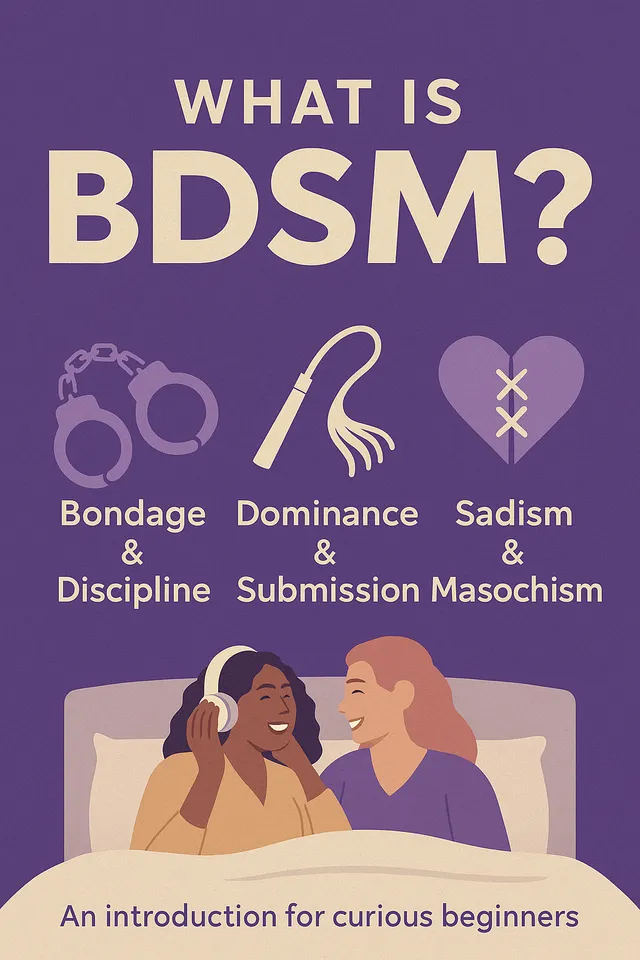What is BDSM?
Understanding the Spectrum of Power, Play, and Intimacy
If you’ve ever seen the acronym BDSM and thought “Isn’t that just Fifty Shades stuff?”—you’re not alone. But there’s a lot more to BDSM than ropes and red rooms. At its heart, BDSM is about communication, trust, and consensual exploration between adults who want to spice up their intimacy in ways that feel bold, honest, and exciting.
Let’s break it down.

What Does BDSM Stand For?
BDSM is an umbrella term made up of three pairs of concepts:
- Bondage & Discipline
- Dominance & Submission
- Sadism & Masochism
Each pair explores different types of power dynamics or sensation-based play:
- Bondage & Discipline involves restraint and rule-following. This might mean using cuffs or ropes, or simply giving commands and rewards.
- Dominance & Submission (D/s) focuses on consensual power exchange. One partner takes the lead (Dominant), while the other follows (Submissive).
- Sadism & Masochism refers to giving or receiving pain for pleasure—but it’s not required to enjoy BDSM.
These concepts often overlap and can be mixed and matched depending on your interests. One person might enjoy light bondage but have no interest in pain or power play. Another might love being told what to do without any physical restraint.
There’s no one way to do BDSM.
What BDSM Is Not
To clear up some common myths:
- BDSM is not abuse. Everything must be consensual, negotiated, and safe. If someone is using BDSM as a cover for non-consensual behavior, that’s abuse—not kink.
- BDSM isn’t always sexual. Some people enjoy the dynamic, the ritual, or the sensation without it leading to intercourse.
- You don’t need to be a lifestyle kinkster. You can be “vanilla” most of the time and just enjoy the occasional playful scene. That’s valid!
Why Do People Practice BDSM?
There are countless reasons people explore BDSM:
- Heightened Sensation: Removing sight, movement, or control often amplifies physical and emotional experiences.
- Emotional Intimacy: Letting someone restrain or direct you (or doing so for them) builds massive trust.
- Power Play: For some, swapping roles or playing with power can feel freeing, cathartic, or deeply erotic.
- Exploration and Self-Discovery: BDSM can be a path to learning what feels good, what turns you on, and how you express yourself sexually or emotionally.
Many couples also report that trying BDSM enhances their communication outside the bedroom too.
Consent: The Foundation of BDSM
The most important thing to understand: BDSM is consensual. Always.
This means:
- You talk before anything happens.
- You agree on what’s okay, what’s not, and how to stop if needed.
- You check in afterwards.
This process is often called “negotiation”, and it’s done before the scene (or play) begins. Many couples also use a safe word—something like “red” or “pineapple”—that immediately stops the action if someone needs a break.
Without this consent and communication, BDSM becomes unsafe and unethical. That’s why responsible kinksters emphasize “safe, sane, and consensual” or “risk-aware consensual kink (RACK)” as guiding principles.
Is BDSM Painful?
It can be—but it doesn’t have to be.
Pain can be pleasurable for some people. That might include spanking, scratching, or using toys like paddles or floggers. But for others, BDSM is more about psychological play (like dominance) or sensory experiences (like blindfolding).
There’s a whole world of “soft BDSM” that includes light bondage, teasing, roleplay, and other activities that are more about control and sensation than intensity or pain.
Beginner-Friendly Ways to Explore BDSM
If you’re curious but unsure where to start, here are some low-pressure ideas:
- Blindfold Play: Enhances other senses and adds mystery.
- Light Spanking: With a hand or a soft paddle.
- Wrist Ties with Scarves or Velcro Cuffs: Restriction without discomfort.
- Tease and Denial: Flirting with arousal and control.
- Dirty Talk and Roleplay: No props needed—just imagination.
Start small. Talk it through. Have fun.
How KnotLove Supports Exploration
At KnotLove, we know that talking about sex—especially kink—can feel awkward. That’s why our app is built to help couples share their desires privately and safely.
With KnotLove:
- You each explore fantasies at your own pace.
- Only mutual interests are shown—no pressure or awkward reveals.
- You get guided activities and ideas for trying new things, including BDSM.
- You can pause or update your interests anytime.
Whether you’re curious about light bondage, submission, or simply want to learn more, KnotLove helps couples explore together—without shame, pressure, or judgment.
Final Thoughts
BDSM isn’t about being kinky or edgy for the sake of it. It’s about finding what excites, empowers, or connects you—and sharing that with someone you trust.
You don’t need to be an expert. You don’t need fancy gear. You just need a little curiosity, a willingness to communicate, and respect for boundaries.
So if you’ve ever been curious, you’re already halfway there. And we’re here to help with the rest.
Ready to explore? KnotLove makes it easy, fun, and safe.